Saint-Gobain Bundle
How Did Saint-Gobain Rise to Global Prominence?
Journey back in time to uncover the fascinating Saint-Gobain SWOT Analysis and its incredible journey! From its Saint-Gobain origins in 1665, commissioned by the French monarchy, to its current status as a global powerhouse, the Saint-Gobain company has consistently redefined innovation. Discover how a single commission for the Palace of Versailles sparked an industrial revolution in glass manufacturing and beyond.
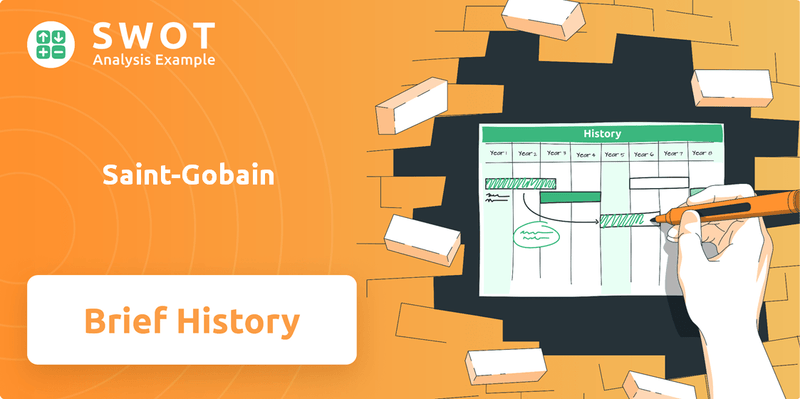
This article delves into the brief history of Saint-Gobain, exploring its Saint-Gobain company founding and the pivotal role it played in shaping the modern world. We'll trace the Saint-Gobain timeline, highlighting key milestones and examining its strategic evolution, including its expansion and acquisitions. You'll gain insights into the Saint-Gobain business and its commitment to sustainability, making it a leader in the construction industry.
What is the Saint-Gobain Founding Story?
The story of the Saint-Gobain company begins in 1665. Originally named the Manufacture Royale des Glaces de Miroirs, its establishment marked a pivotal moment in French industrial history. This initiative was driven by Jean-Baptiste Colbert, the Minister of Finance under King Louis XIV.
Colbert's vision was to end France's dependence on expensive mirror imports from Venice, which held a near-monopoly on high-quality mirror manufacturing. This strategic move aimed to boost French industrial independence and enhance national prestige. The early focus was on producing cast glass, a groundbreaking technique that allowed for larger and more uniform mirror plates.
This innovation was crucial for grand architectural projects, including the Palace of Versailles. The company's early success set the stage for its future evolution and expansion, establishing it as a key player in the global materials market.
Saint-Gobain's origins are deeply rooted in the ambition to achieve industrial self-sufficiency and national prestige. The company's initial success was built on a revolutionary glass-making technique.
- Established in 1665 as Manufacture Royale des Glaces de Miroirs.
- Driven by Jean-Baptiste Colbert to end reliance on Venetian mirror imports.
- Focused on cast glass production for larger, uniform mirror plates.
- Enabled grand architectural projects like the Palace of Versailles.
The Growth Strategy of Saint-Gobain has evolved significantly since its founding. The company's early focus on mirror manufacturing laid the foundation for its expansion into various materials and construction solutions. In the early years, the company's success was tied to its ability to produce high-quality mirrors, a technological feat at the time.
Saint-Gobain's early years were marked by innovation in glass manufacturing. The company's ability to create larger and more uniform mirror plates was a significant technological advancement. This innovation allowed the company to secure contracts for prestigious projects, including the Palace of Versailles. The company's early success was a testament to its commitment to innovation and quality.
Over time, Saint-Gobain has expanded its product offerings and global presence. Today, the company operates in numerous countries and serves various markets, including construction, automotive, and industrial sectors. Its evolution reflects its ability to adapt to changing market demands and technological advancements.
Saint-Gobain's early history is a story of innovation and strategic foresight. Its founding marked a significant step towards French industrial independence and set the stage for its growth into a global leader in materials and construction solutions. The company's focus on quality, innovation, and strategic partnerships has been key to its long-term success.
Saint-Gobain SWOT Analysis
- Complete SWOT Breakdown
- Fully Customizable
- Editable in Excel & Word
- Professional Formatting
- Investor-Ready Format
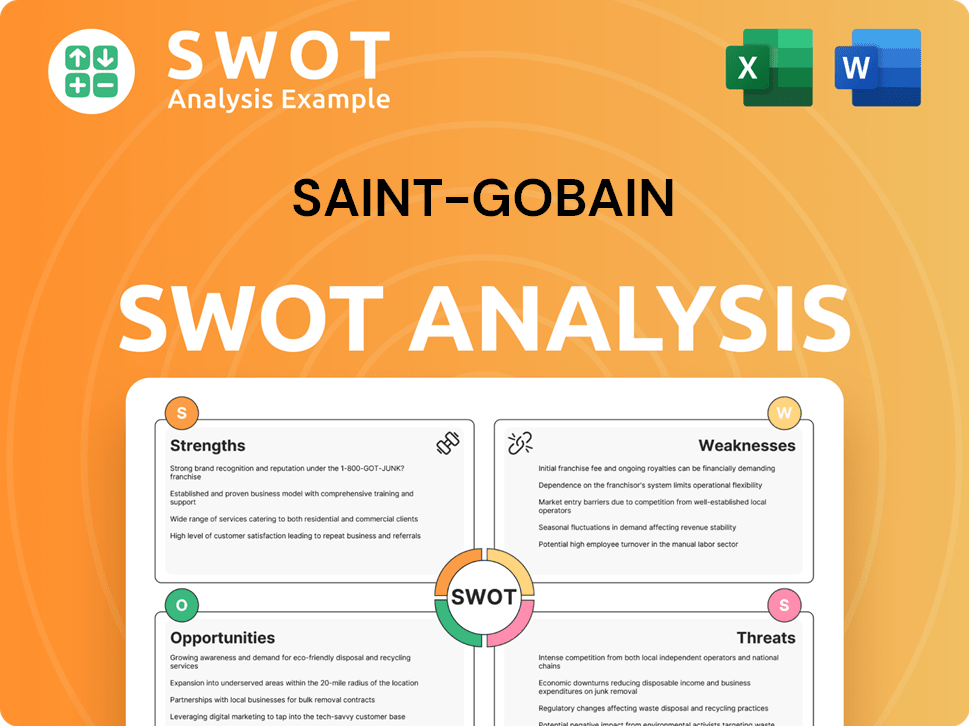
What Drove the Early Growth of Saint-Gobain?
The early history of the Saint-Gobain company, initially known as Manufacture Royale des Glaces de Miroirs, saw rapid establishment as a key player in glass production. Its initial success was closely tied to the French monarchy, notably through the Hall of Mirrors at the Palace of Versailles. This landmark project showcased its innovative cast glass production capabilities, setting the stage for expansion beyond mirrors.
Over its long history, the Saint-Gobain company has consistently evolved its product portfolio and geographic reach. The company entered new markets through both organic growth and strategic acquisitions. In recent years, Saint-Gobain has significantly accelerated its strategic repositioning, particularly towards North America, Asia, and emerging countries.
A key aspect of its recent growth strategy has been a series of impactful acquisitions. In 2024, Saint-Gobain finalized four strategic acquisitions totaling €5 billion: CSR in Australia, Bailey in Canada, OVNIVER (Cemix brand) in Latin America, and FOSROC in India and the Middle East. These acquisitions are projected to add 3% to sales and €200 million to operating profit in 2025.
The company's strategic shifts have also focused on increasing its exposure to the renovation market, which accounts for over 50% of its sales in North America, and leveraging its local business model to protect against customs tariffs. This approach has contributed to a record operating margin of 11.4% in 2024 and €4.0 billion in free cash flow, despite a challenging environment in new construction in Europe.
For instance, the acquisition of FOSROC, completed in February 2025, significantly strengthens Saint-Gobain's presence in construction chemicals, particularly in high-growth emerging markets like India and the Middle East, bringing combined sales in this segment to €6.5 billion across 76 countries. New U.S. plants for roofing and plasterboard are also expected to open in mid-2025, promising returns exceeding 20%. For more insights into the company's financial performance, consider exploring Owners & Shareholders of Saint-Gobain.
Saint-Gobain PESTLE Analysis
- Covers All 6 PESTLE Categories
- No Research Needed – Save Hours of Work
- Built by Experts, Trusted by Consultants
- Instant Download, Ready to Use
- 100% Editable, Fully Customizable
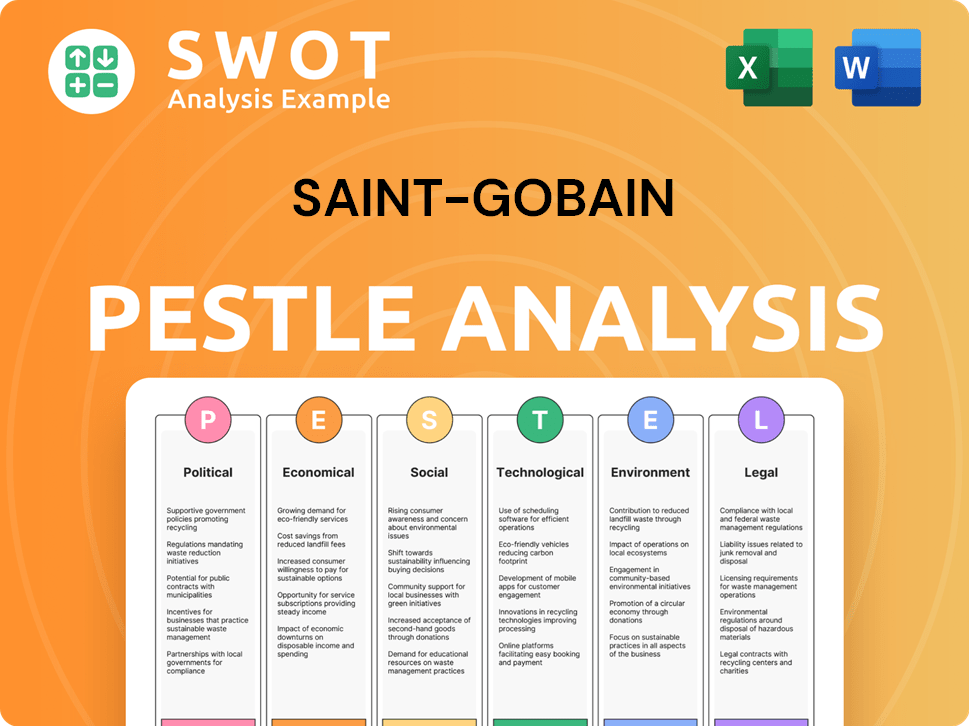
What are the key Milestones in Saint-Gobain history?
The Saint-Gobain company's journey is marked by significant milestones, reflecting its evolution from its origins to a global leader in sustainable construction and innovative materials. The Saint-Gobain history showcases a company that has adapted and thrived through centuries of change.
| Year | Milestone |
|---|---|
| 1665 | Saint-Gobain was established by Jean-Baptiste Colbert to manufacture mirrors for the Palace of Versailles, marking the Saint-Gobain company founding. |
| 1665-1789 | The company focused on mirror manufacturing, developing innovative techniques and expanding its operations. |
| 1830s | Saint-Gobain expanded into the chemical industry, diversifying its product range and market presence. |
| 19th Century | The company embraced the industrial revolution, adopting new technologies and expanding its manufacturing capabilities. |
| 20th Century | Saint-Gobain expanded globally through acquisitions and organic growth, becoming a multinational corporation. |
| 2021 | Launched the 'Grow & Impact' strategic plan to reposition the Group. |
| 2024 | Invested €600 million in R&D and filed over 450 patents. |
Saint-Gobain has consistently been at the forefront of innovation in material science and sustainable solutions, as the Revenue Streams & Business Model of Saint-Gobain details. For instance, the company introduced ORAÉ®, a low-carbon glass with high recycled content. Recent innovations include FireLITE®, a lightweight fire-resistant plasterboard, and ClimateFlex® products, a reinforced roofing technology.
Saint-Gobain was the first to introduce a low-carbon glass offer, ORAÉ®, featuring high recycled content.
FireLITE® is a lightweight fire-resistant plasterboard, enhancing building safety.
ClimateFlex® products offer reinforced roofing technology, designed to withstand extreme weather events.
In 2024, the company invested €600 million in R&D, demonstrating a strong commitment to innovation.
The company filed over 450 patents in 2024, showcasing its continuous innovation efforts.
Saint-Gobain signed around 35 investment or collaboration agreements with startups in 2024, fostering external innovation.
Despite its achievements, Saint-Gobain has faced challenges such as market downturns and competitive pressures. The new construction sector in Europe has remained sluggish, though renovation markets have provided stability. The company has responded with strategic pivots and a focus on operational agility, including the 'Grow & Impact' plan.
Saint-Gobain has faced challenges due to market downturns, particularly in the new construction sector.
Sales in Southern Europe, the Middle East & Africa fell 7.3% in 2024, highlighting regional disparities.
The 'Grow & Impact' strategic plan, launched in 2021, has driven a significant repositioning of the Group.
Almost 40% of Group sales have been rotated since 2018 through divestments and acquisitions.
Saint-Gobain is focusing on high-growth regions and sectors like construction chemicals.
The company has a strong commitment to sustainability, with a 34% reduction in Scope 1/2 CO2 emissions since 2017.
Saint-Gobain Business Model Canvas
- Complete 9-Block Business Model Canvas
- Effortlessly Communicate Your Business Strategy
- Investor-Ready BMC Format
- 100% Editable and Customizable
- Clear and Structured Layout
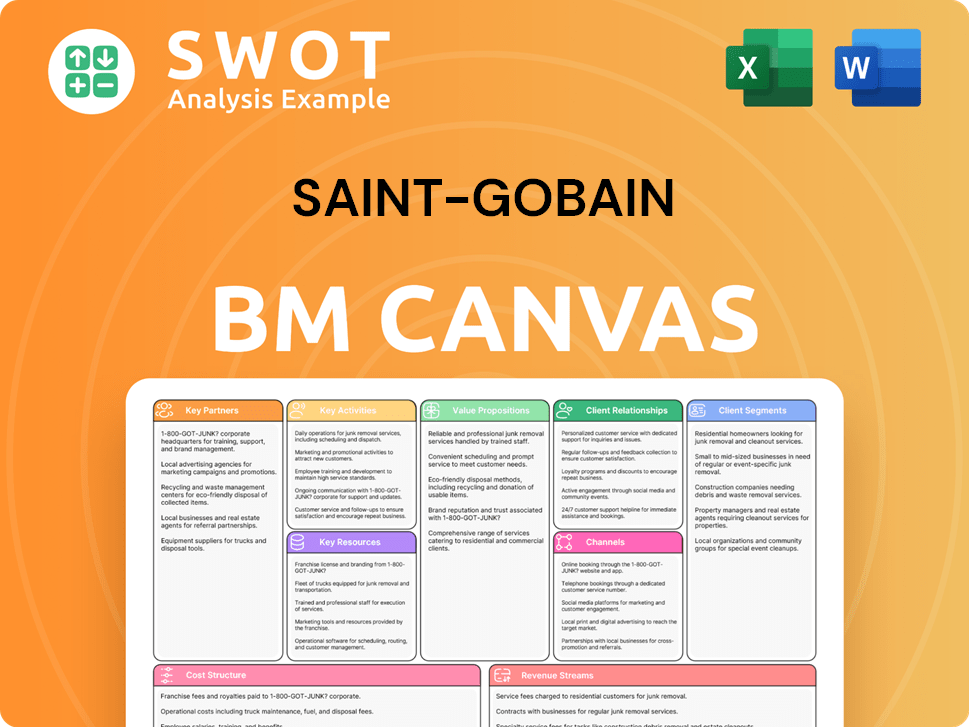
What is the Timeline of Key Events for Saint-Gobain?
The brief history of Saint-Gobain showcases a journey of continuous innovation and strategic adaptation within the construction materials sector, evolving from its
| Year | Key Event |
|---|---|
| 1665 | Founding of the Manufacture Royale des Glaces de Miroirs in France, marking the beginning of |
| 2017 | Committed to a 34% reduction in Scope 1 & 2 CO2 emissions by 2024 compared to 2017, highlighting its sustainability focus. |
| 2018 | Began digital transformation to unify global innovation in R&D, enhancing operational efficiency. |
| 2021 | Launched the 'Grow & Impact' strategic plan, aiming for global leadership in light and sustainable construction. |
| 2024 (January) | Awarded 'Top Employer Global' certification for the 9th consecutive year, emphasizing its commitment to its employees. |
| 2024 (February 27) | Reported record operating margin (11.4%), free cash flow (€4.0bn), and recurring EPS for full-year 2024, demonstrating strong financial performance. |
| 2024 (June 27) | Announced the acquisition of FOSROC, a leading construction chemicals player, expanding its presence in key markets. |
| 2024 (July 25) | Announced first-half 2024 results, with a record operating margin of 11.7%. |
| 2024 (August 15) | Announced acquisition of OVNIVER Group (Cemix brand), a leading construction chemicals player in Mexico and Central America. |
| 2024 (October) | Acquired Kilwaughter Minerals, a provider of construction aggregates and insulation materials, further diversifying its portfolio. |
| 2024 (October 10) | Showcased latest glass innovations at Glasstec 2024, including low-carbon glass ORAÉ®, emphasizing its commitment to sustainable solutions. |
| 2025 (January 28) | Recognized as 'Top Employer Global' for the 10th consecutive year. |
| 2025 (February 9) | Completed the acquisition of FOSROC, integrating the new business into its operations. |
| 2025 (February 19) | Innovated with an AI-created campaign on the city of the future, showcasing its forward-thinking approach. |
| 2025 (April 24) | Reported first-quarter 2025 sales up 3.2% to €11.7 billion and confirms 2025 outlook of an operating margin of more than 11.0%, reflecting continued growth. |
| 2025 (Mid-2025) | New capacity in plasterboard, roofing, and glass mat underlayment expected to come online in North America, increasing production capabilities. |
| 2025 (October 6) | Will share new ambitions at its Investor Day, reflecting the continuation of its strategy for worldwide leadership in light and sustainable construction. |
The company anticipates a gradual recovery in Western Europe's construction markets in the second half of 2025. Strong activity is expected to continue in North America and Latin America. Growth in Asia-Pacific will be led by India and the integration of CSR in Australia.
The company aims for an operating margin of more than 11.0% in 2025, surpassing its initial strategic plan objective. The acquisitions, such as Fosroc, are projected to add €2 billion in annual sales. Debt management aims for a net debt/EBITDA ratio below 1.5x.
Continued sustainable innovation is a key focus, with the launch of low-carbon products to capitalize on the global green building market. The seamless integration of recent acquisitions is crucial for boosting margins and market share. A €400 million share buyback program is planned for 2025.
A 5% dividend hike to €2.20 per share is planned, reflecting confidence in cash flow stability. The company’s long-term vision remains aligned with its founding purpose of 'Making the World a Better Home'.
Saint-Gobain Porter's Five Forces Analysis
- Covers All 5 Competitive Forces in Detail
- Structured for Consultants, Students, and Founders
- 100% Editable in Microsoft Word & Excel
- Instant Digital Download – Use Immediately
- Compatible with Mac & PC – Fully Unlocked
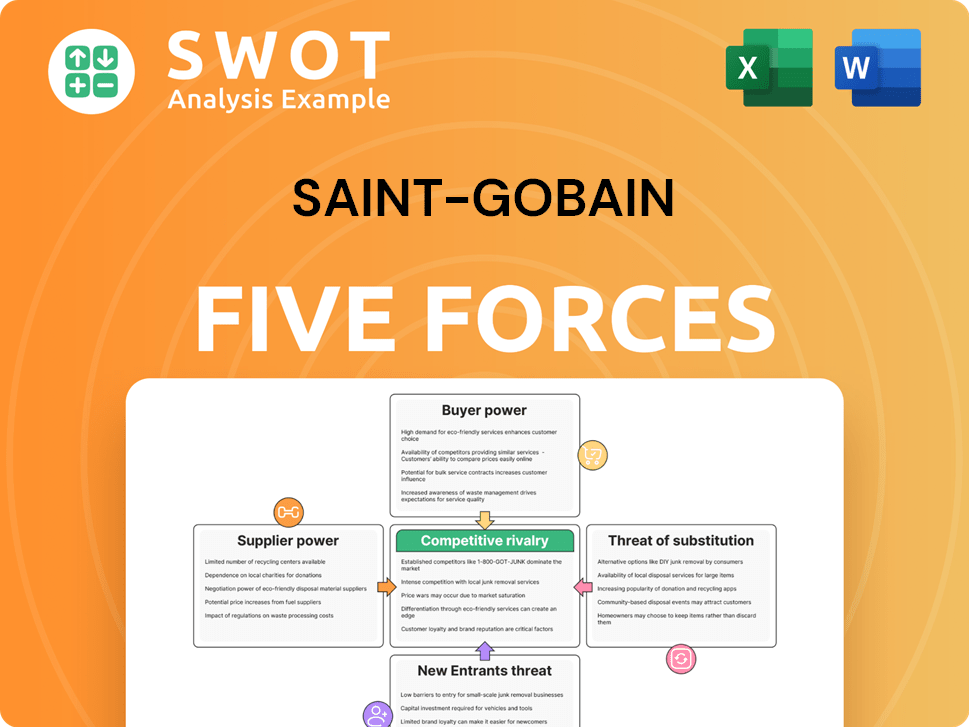
Related Blogs
- What is Competitive Landscape of Saint-Gobain Company?
- What is Growth Strategy and Future Prospects of Saint-Gobain Company?
- How Does Saint-Gobain Company Work?
- What is Sales and Marketing Strategy of Saint-Gobain Company?
- What is Brief History of Saint-Gobain Company?
- Who Owns Saint-Gobain Company?
- What is Customer Demographics and Target Market of Saint-Gobain Company?
Disclaimer
All information, articles, and product details provided on this website are for general informational and educational purposes only. We do not claim any ownership over, nor do we intend to infringe upon, any trademarks, copyrights, logos, brand names, or other intellectual property mentioned or depicted on this site. Such intellectual property remains the property of its respective owners, and any references here are made solely for identification or informational purposes, without implying any affiliation, endorsement, or partnership.
We make no representations or warranties, express or implied, regarding the accuracy, completeness, or suitability of any content or products presented. Nothing on this website should be construed as legal, tax, investment, financial, medical, or other professional advice. In addition, no part of this site—including articles or product references—constitutes a solicitation, recommendation, endorsement, advertisement, or offer to buy or sell any securities, franchises, or other financial instruments, particularly in jurisdictions where such activity would be unlawful.
All content is of a general nature and may not address the specific circumstances of any individual or entity. It is not a substitute for professional advice or services. Any actions you take based on the information provided here are strictly at your own risk. You accept full responsibility for any decisions or outcomes arising from your use of this website and agree to release us from any liability in connection with your use of, or reliance upon, the content or products found herein.